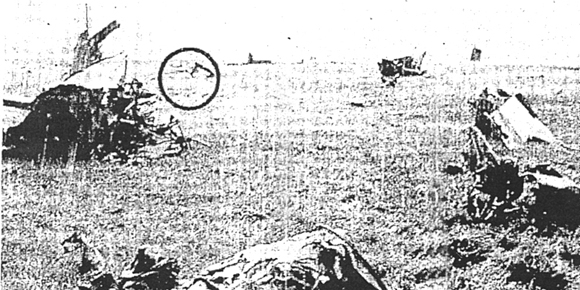by Bruce Cherney (part 2)
Ethel Howard, a reporter with the Lake Centre News, related that the military personnel, who witnessed the fatal crash of Red Knight pilot Flight-Lieutenant J.W. “Bud” Morin on August 21, 1963, during Gimli Air Force Day, agreed that it was a “needless waste of life.”
When he met his death, while flying the brilliant red painted T-33 Silver Star, at RCAF (Royal Canadian Air Force) Station Gimli, Morin was just 25 years old. At the time of the fatal crash, he was stationed at RCAF Station Portage la Prairie.
Morin was born in Maniwaki, Quebec, and had joined the RCAF in London, Ontario. He left to mourn his passing his wife, Marjorie, and their two children, Marjorie and Michael.
Howard further wrote that she could accept the fact “that fatalities are inevitable in the training of pilots, but aerobatic performances provided solely for the entertainment of a thrill-seeking public are an unnecessary part of our national defence.”
A former Red Knight would later disagree with Howard’s assessment.
“There is no more danger in aerobatics than there is any other type of flying,” Bill Slaughter told reporter John McManus for a May 5, 1975, Winnipeg Free Press article that noted the deadly crash at Gimli 12 years earlier. “There is a purpose behind a Red Knight or an aerobatic team that can be justified even if they perform only at our bases.
“It’s an excellent way of giving equipment extensive trials and increase our knowledge to quickly see problems before they occur in regular forces flying.”
Crashes and deaths of RCAF pilots while training at RCAF Station Gimli — for that matter at all Manitoba RCAF bases — seem to have been somewhat common.
On April 9, 1956, student pilot A. P. Moore, 22, died when his T-33 trainer crashed about 16 kilometres north of the air base and a kilometre from the shore of Lake Winnipeg. Two weeks earlier, NATO student pilot R.L. Dornic of Brest, France, also died when his plane crashed near the lake. On November 27 that year, another NATO student pilot from CFB Gimli crashed near Libau and was killed. In 1957, another NATO student pilot flying out of Gimli was killed in a crash near Chatfield.
Two Gimli-based air force officer pilots, E.L. Fine and G.S. Graham, died when their T-33 crashed at Elmhurst Golf Course on March 9, 1959. In August that year, two NATO trainees died when their T-33 crashed at Hecla Island.
With the exception of the two flight officers, the T-33 crashes recorded above involved untried student pilots — pilot error was probably the cause of most of the incidents.
Claude Montour in A Pilot’s Diary, 1954-60 (RCAF, Department of National Defence C/M Publications, 2004) wrote about an incident over Gimli base involving two student pilots and their deaths resulting from a mid-air collision. He emphasized how a rookie’s mistakes can have deadly consequences.
For his entry on September 20, 1954, he wrote: “... one of the members of the course next to ours, collided with one of his companion (sic) in mid-air: both trainees were killed, pulverized instantly.
“The last words recorded originating from one of them were: YOU TURN LEFT, I TURN RIGHT ... Fatal error: in doing so while heading for each other both turned in the same direction resulting in the inevitable. Time after time we were told from the beginning: ALWAYS turn RIGHT to avoid collisions, instinctively!”
Actually, that was one the first of two mid-air collisions involving T-33 jets based in Gimli that year. On October 21, two aircraft collided over Lake Winnipeg. French trainee pilot Marcel Ceret successfully bailed out and two others in the second aircraft, C.R. Fletcher of Edmonton and T.D. Wheeler of Winnipeg, were killed.
The 1963 Red Knight crash wasn’t the first time a T-33 pilot was killed during a Gimli Air Force Day aerobatic display. On June 8, 1957, Flight Officer K. Gordon Brown, 26, a staff instructor at RCAF Station Gimli, had been in the air for about 25 minutes and “had completed two climbing rolls and was diving down and across the field to pick up speed for his next manoeuvre when his plane hit the ground about one mile from the crowd, and burst into a ball of flame” (Free Press, June 10, 1957).
As in 1963, the show went on despite the tragedy.
“There were problems with the T-33 when it was first developed as there are with every new plane. A newspaper article in 1959 (March 11, Winnipeg Free Press) stated that in the preceding four years 57 Manitoba-based jets had crashed with 54 dead,” according to a July 5, 1969, Free Press article by Frances Bidewell.
“In March of that year three pilots were killed within 12 hours in two different crashes and the week before a NATO student had been killed in the crash of a T-33.
“But an earlier investigation had shown the plane to be a ‘high-performance aircraft which was basically sound,’ the article said. Each crash had a different cause with the standard cause being pilot’s error.”
The article citing the investigation quoted by Bidewell appeared in the March 10, 1959, Free Press. According to the article, there had been a public outcry against the T-33 two years earlier “because of the number of crashes.”
“There had never been any criticism of the plane within the RCAF and investigation revealed that each crash had a different cause, he (an RCAF spokesman) said.”
Another article on March 14 in the same newspaper reported that: “The RCAF contends that its accident rate on T-33s has declined since the three-phase training program was re-instituted. An air force spokesman at Ottawa said ... there had been a decided improvement in the accident flying rate for the number of flying hours spent in T-33s.”
(Next week: part 3)



